My most current blog entry:
October Thai Visitors = Scottish Road Trip
 Sunday, December 11, 2016 at 7:25PM
Sunday, December 11, 2016 at 7:25PM  I love having friends and family visit us here in Scotland . . . we get to take them around the country and share good times together. I also get to take my camera and shoot some pics. We headed south out of Aberdeen for a little time in Edinburgh first.
I love having friends and family visit us here in Scotland . . . we get to take them around the country and share good times together. I also get to take my camera and shoot some pics. We headed south out of Aberdeen for a little time in Edinburgh first.
 The Royal Mile is always the first stop in Edinburgh. Although it is touristic, it is also stunningly beautiful.
The Royal Mile is always the first stop in Edinburgh. Although it is touristic, it is also stunningly beautiful.
 The Scottish Parliament sits astride the Royal Mile.
The Scottish Parliament sits astride the Royal Mile.
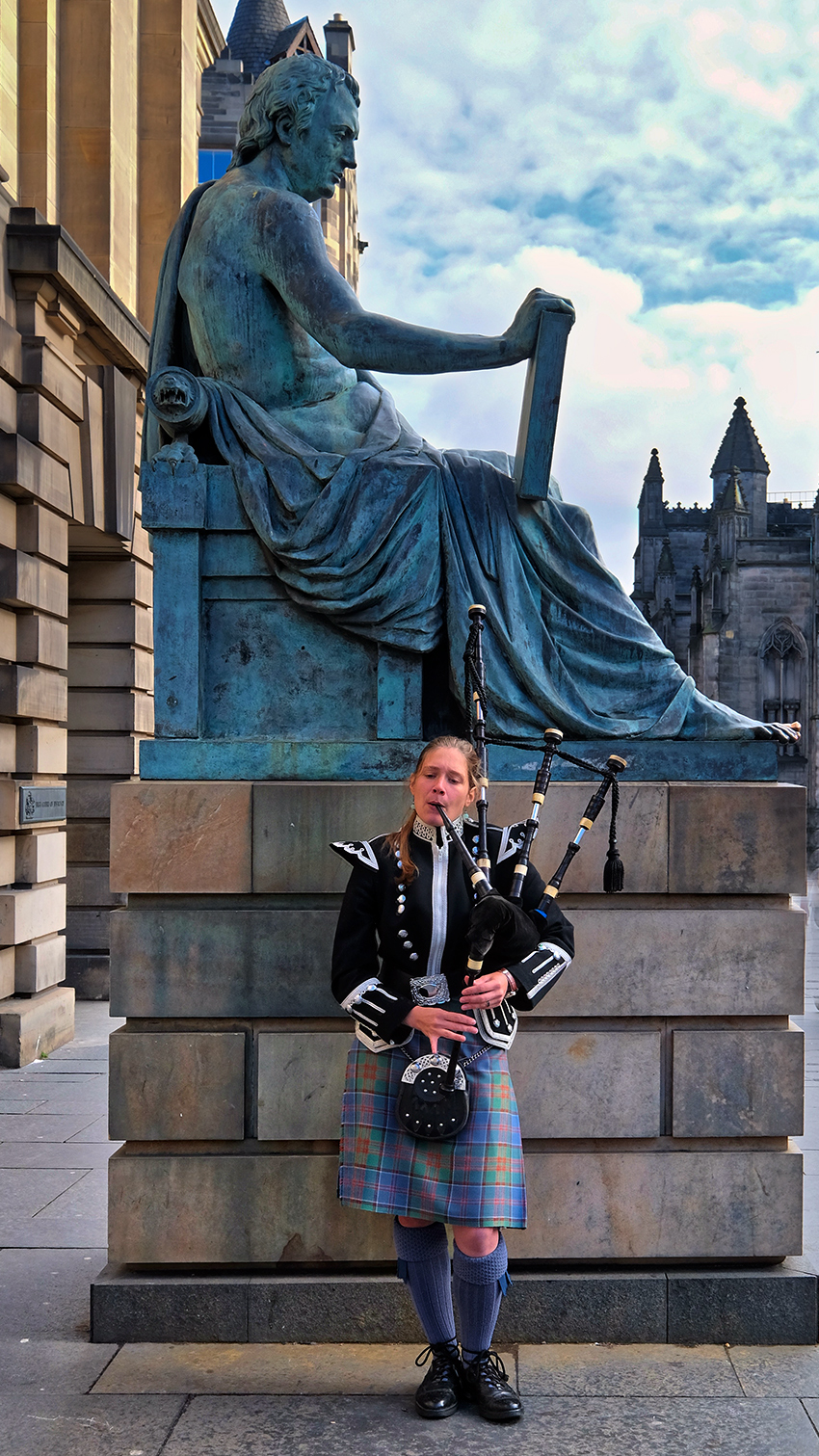 The philosopher Hume called Edinburgh home, as does this bonny lass busking with her pipes.
The philosopher Hume called Edinburgh home, as does this bonny lass busking with her pipes.
 The Royal Mile leads up to Edinburgh Castle. I loved this old cafe truck.
The Royal Mile leads up to Edinburgh Castle. I loved this old cafe truck.
 I bought a cafe latte here . . . of course.
I bought a cafe latte here . . . of course.
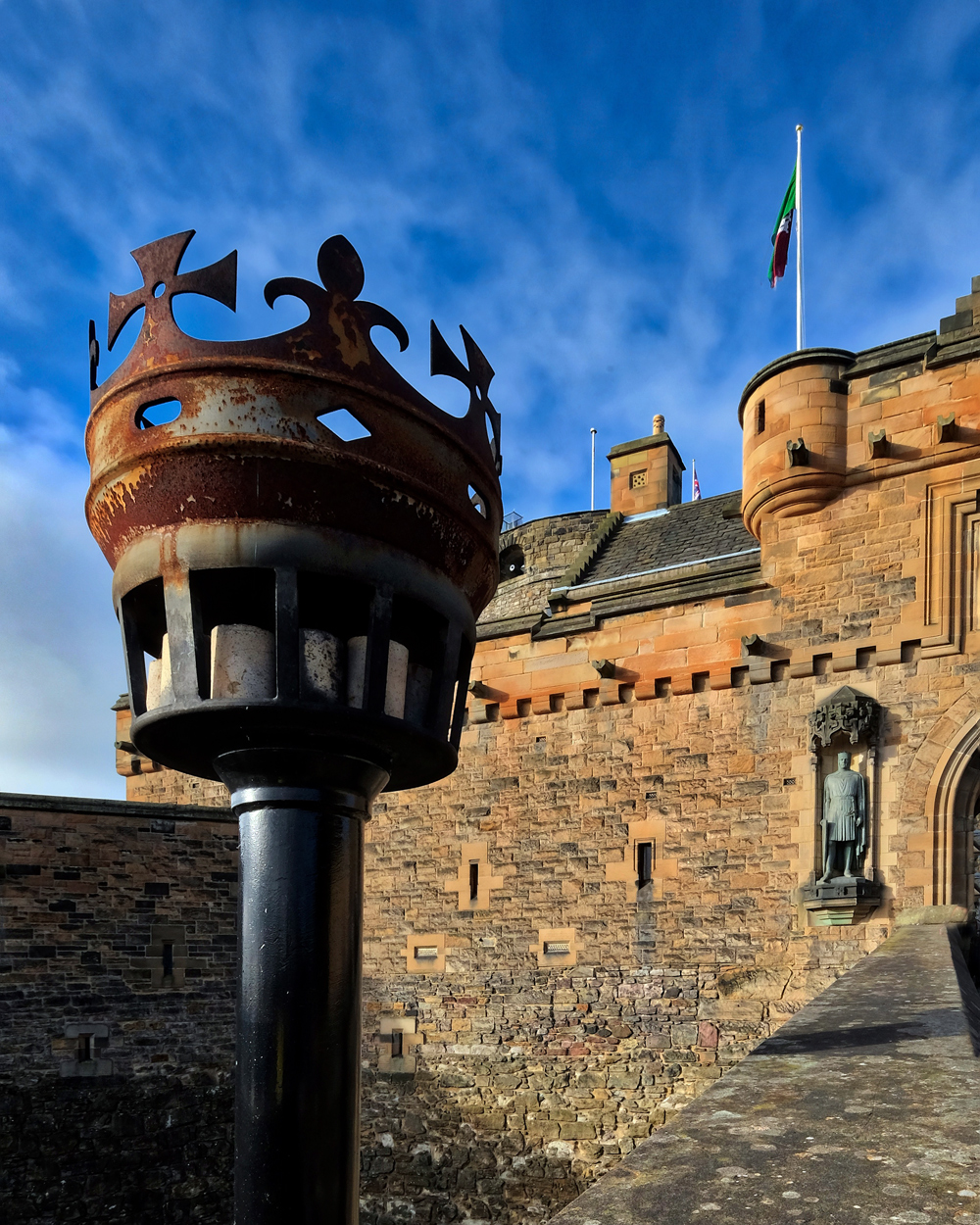 Edinburgh Castle dominates the city skyline . . . and is absolutely fantastic.
Edinburgh Castle dominates the city skyline . . . and is absolutely fantastic.
 The Edinburgh Castle drawbridge and gate. There has been a castle on this location since at least the 2nd century AD, although there have been many rebuilds and additions since then.
The Edinburgh Castle drawbridge and gate. There has been a castle on this location since at least the 2nd century AD, although there have been many rebuilds and additions since then.
 Once inside the castle walls, an ancient world unfolds.
Once inside the castle walls, an ancient world unfolds.
 Edinburgh Castle is a 'living' castle: these offices are in current use by the Royal Family for administrative purposes.
Edinburgh Castle is a 'living' castle: these offices are in current use by the Royal Family for administrative purposes.
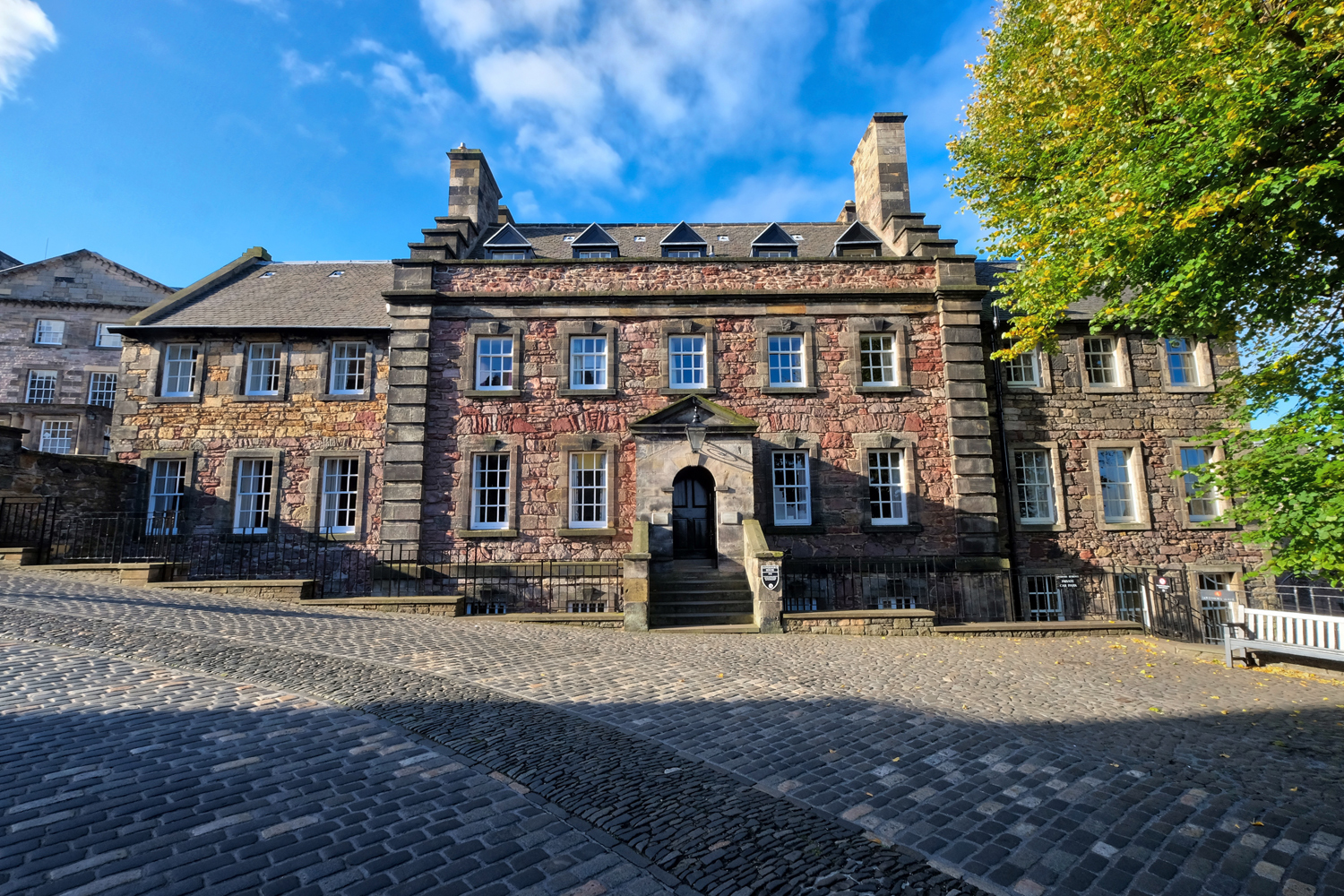 Inside the castle walls.
Inside the castle walls.
 I love that the Scottish National Trust has young men circulating in period WWI military dress . . . a reminder of wars gone by . . . and the human toll.
I love that the Scottish National Trust has young men circulating in period WWI military dress . . . a reminder of wars gone by . . . and the human toll.
 Of curse, the castle is a defensive position and is ringed with canon emplacements.
Of curse, the castle is a defensive position and is ringed with canon emplacements.
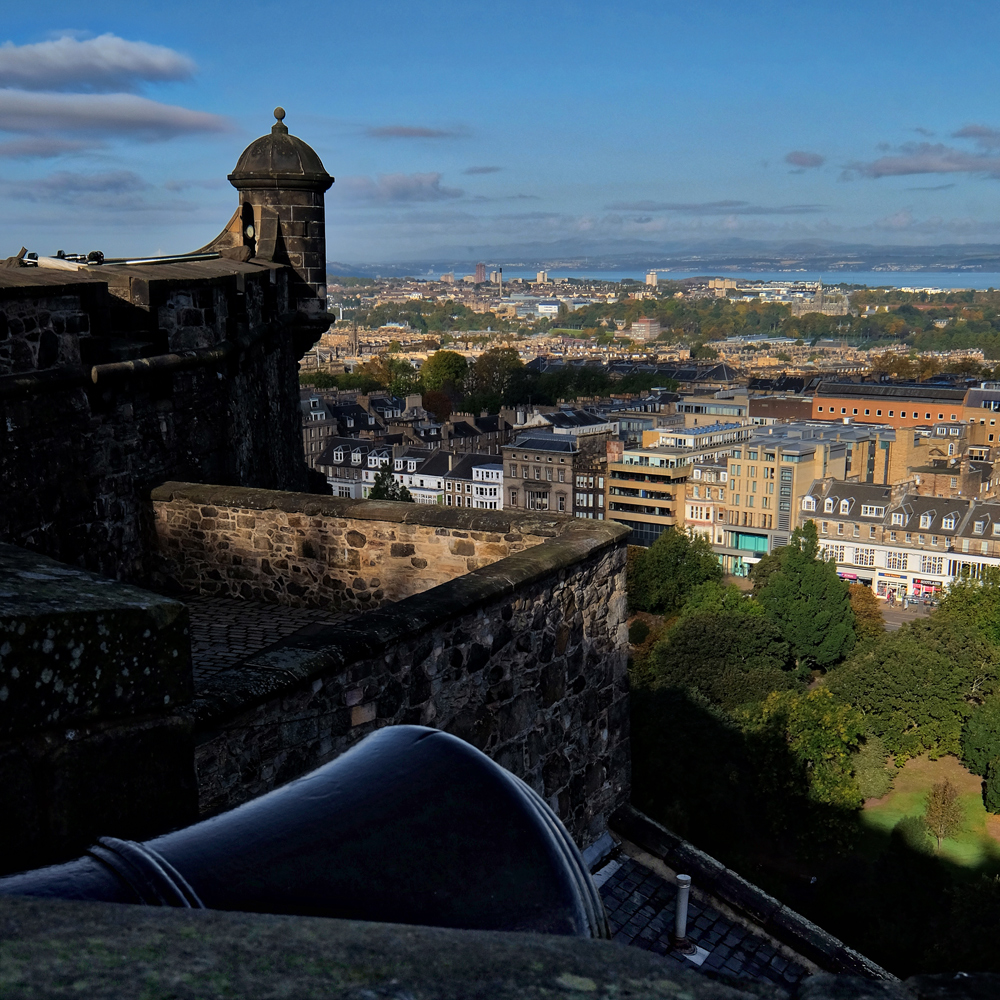 The gun emplacements had the best views of Edinburgh.
The gun emplacements had the best views of Edinburgh.
 Looks dangerous.
Looks dangerous.
 It's always good to have the high ground in a siege.
It's always good to have the high ground in a siege.
 There are wonderful views of Edinburgh city from the castle ramparts.
There are wonderful views of Edinburgh city from the castle ramparts.
 A small chapel within the castle walls.
A small chapel within the castle walls.
 We were at the castle as soon as it opened in the morning . . . to get the best photo opportunities, but it quickly filled up with tourists. Here, an inner courtyard outside the grand hall.
We were at the castle as soon as it opened in the morning . . . to get the best photo opportunities, but it quickly filled up with tourists. Here, an inner courtyard outside the grand hall.
 Inside the magnificent grand hall!
Inside the magnificent grand hall!
 A sumptuous castle interior.
A sumptuous castle interior.
 We enjoyed several days of sightseeing in Edinburgh, but the call of The Highlands and more historic sites beckoned.
We enjoyed several days of sightseeing in Edinburgh, but the call of The Highlands and more historic sites beckoned.
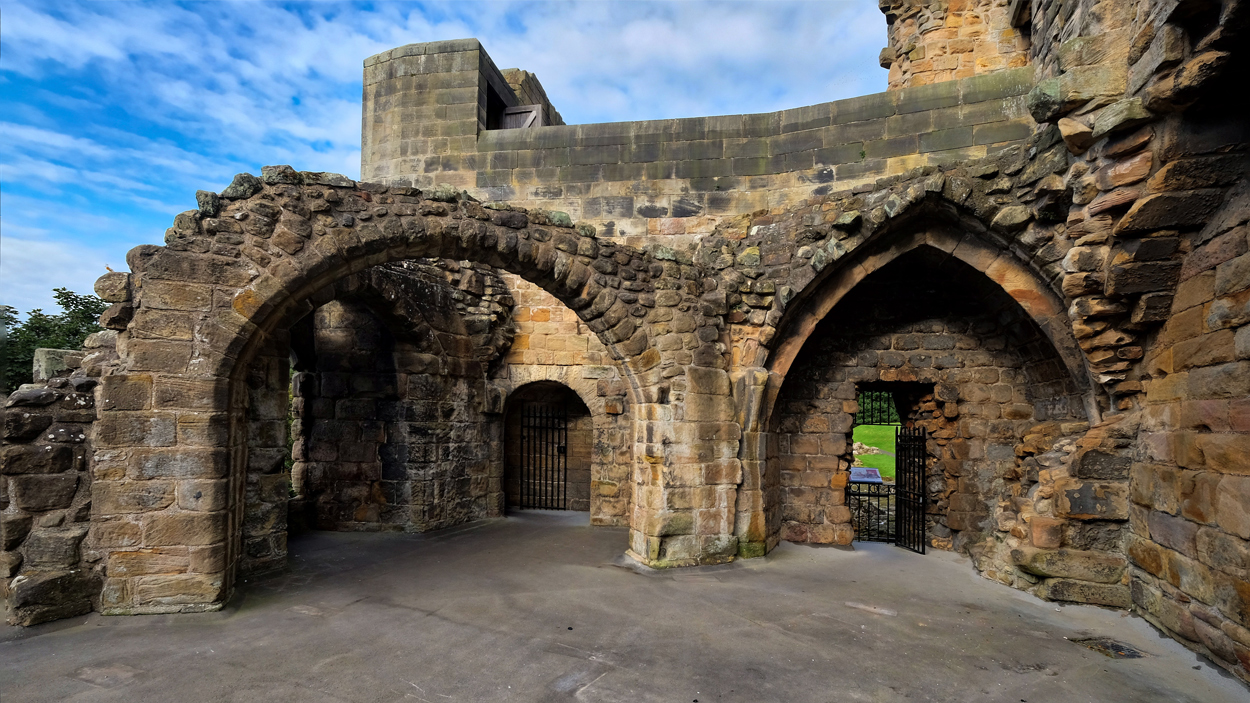 From Edinburgh we headed northwest and to ancient town of Dunfermline, which served as the royal capitol of Scotland until the 17th century. Here we have the ruins of the 11th century Dunfermline Palace.
From Edinburgh we headed northwest and to ancient town of Dunfermline, which served as the royal capitol of Scotland until the 17th century. Here we have the ruins of the 11th century Dunfermline Palace.
 Dunfermline Palace ruins.
Dunfermline Palace ruins.
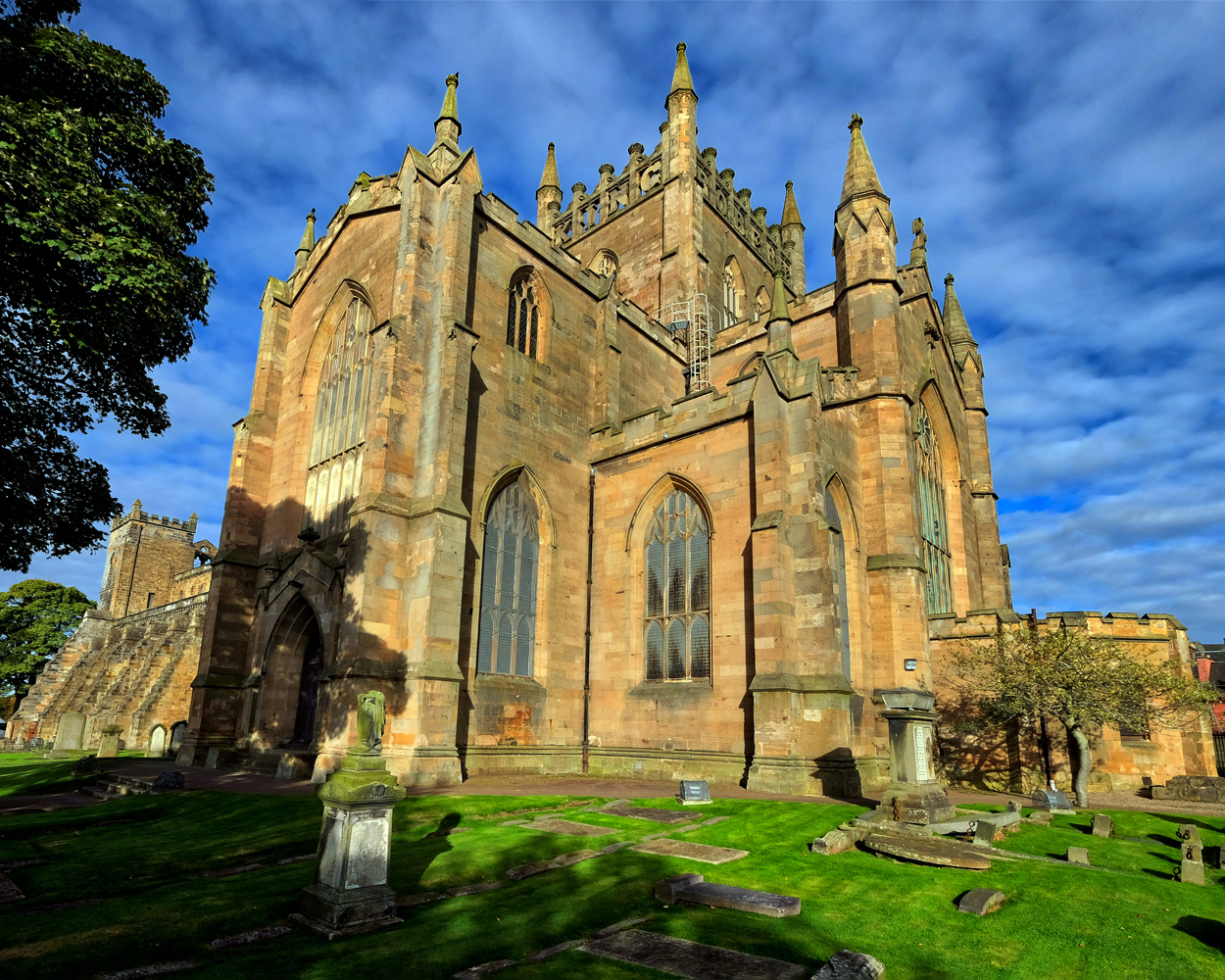 Adjacent to the palace ruins sits the intact Dunfermline Abbey (c. 1128). A perfect October day in Scotland!
Adjacent to the palace ruins sits the intact Dunfermline Abbey (c. 1128). A perfect October day in Scotland!
 The immense ancient Dunfermline Abbey.
The immense ancient Dunfermline Abbey.
 The interior view of the old section of Dunfermline Abbey.
The interior view of the old section of Dunfermline Abbey.
 Beautiful vaulted ceilings.
Beautiful vaulted ceilings.
 A working mill near Pitlochry.
A working mill near Pitlochry.
 We actually bought 'heretage' stone ground organic flour from the mill . . . it makes the BEST pan cakes!
We actually bought 'heretage' stone ground organic flour from the mill . . . it makes the BEST pan cakes!
 A stunning scene.
A stunning scene.
My Scottish Garden In Autumn (+ Macro)
 Sunday, November 6, 2016 at 12:49AM
Sunday, November 6, 2016 at 12:49AM  It's Autumn in Scotland . . . and my garden is alive with color and wonder.
It's Autumn in Scotland . . . and my garden is alive with color and wonder.
 The days are getting shorter . . and many of the birds have gone.
The days are getting shorter . . and many of the birds have gone.
 The leaves have gone red . . .
The leaves have gone red . . .
 . . . or golden.
. . . or golden.
 The apples are ready to harvest in the far end of the garden.
The apples are ready to harvest in the far end of the garden.
 The garden is very old and the original planter created a garden that has continuous flowering . . . when one plant fades, another comes into bloom. These are still flowering in late October.
The garden is very old and the original planter created a garden that has continuous flowering . . . when one plant fades, another comes into bloom. These are still flowering in late October.
 These miniatures grow from the nooks an crannies of the garden wall.
These miniatures grow from the nooks an crannies of the garden wall.
 The garden hedge sprouted these blossom buds recently . . . although they have not opened, they attract large numbers of bees, wasps, and flies.
The garden hedge sprouted these blossom buds recently . . . although they have not opened, they attract large numbers of bees, wasps, and flies.
 There is a great variety of foliage throughout the garden.
There is a great variety of foliage throughout the garden.
 The roses were among the first to bloom . . . and they are still producing amazing flowers.
The roses were among the first to bloom . . . and they are still producing amazing flowers.
 And there are more roses yet to come.
And there are more roses yet to come.
 These popped out a couple of weeks ago . . . right before I was going to pull them out, thinking they were weeds! Close call.
These popped out a couple of weeks ago . . . right before I was going to pull them out, thinking they were weeds! Close call.
 Autumn weather can be wet and wild in Scotland . . . and occasionally throws up amazing rainbows. I watched this one go through many phases . . .
Autumn weather can be wet and wild in Scotland . . . and occasionally throws up amazing rainbows. I watched this one go through many phases . . .
 This rainbow ended in this striking streaked image.
This rainbow ended in this striking streaked image.
 Fast moving clouds full of rain cross the landscape continuously.
Fast moving clouds full of rain cross the landscape continuously.
 Rain and shafts of light. Beautiful.
Rain and shafts of light. Beautiful.
 Occasionally there is a window in the storms and a glimpse of the sky appears. Sometimes there is magical light that pours through the holes in the sky . . .
Occasionally there is a window in the storms and a glimpse of the sky appears. Sometimes there is magical light that pours through the holes in the sky . . .
 And when the sun pours through . . . .
And when the sun pours through . . . .
 These back-lit 'silver dollar' leaves . . .
These back-lit 'silver dollar' leaves . . .
 So beautiful.
So beautiful.
 And when the garden stops flowering . . . I have house plants.
And when the garden stops flowering . . . I have house plants.
 Dr. Jeff Harper
Dr. Jeff Harper
MACRO LENS IN THE GARDEN
 It was a beautiful clear, late November afternoon with perfect 'magic hour' light . . . . why not throw the macro extension tube on the old Fuji X-T1 and go out and shoot bugs and flowers . . . .
It was a beautiful clear, late November afternoon with perfect 'magic hour' light . . . . why not throw the macro extension tube on the old Fuji X-T1 and go out and shoot bugs and flowers . . . .
 Flies sharing the pollination duties on our late-blooming hedge.
Flies sharing the pollination duties on our late-blooming hedge.
 Our hedges throw out these amazing miniature blossoms in great numbers and variety.
Our hedges throw out these amazing miniature blossoms in great numbers and variety.
 The bees were stocking up on pollen for the long winter months to come.
The bees were stocking up on pollen for the long winter months to come.
 Busy bees.
Busy bees.
 Marvelous light . . . .
Marvelous light . . . .
 These photos were all taken with my Fuji X-T1, 56mm f1.2 lens and Fuji macro tube.
These photos were all taken with my Fuji X-T1, 56mm f1.2 lens and Fuji macro tube.
 Pollen-laden bee . . . on the rounds.
Pollen-laden bee . . . on the rounds.
 Micro world.
Micro world.
 Bee bloom portrait.
Bee bloom portrait.
 I think this is my best macro bee portrait.
I think this is my best macro bee portrait.
 I came back inside the house to look at the bee pics and was taken by the light in the conservatory . . . . perfect for house plant macro.
I came back inside the house to look at the bee pics and was taken by the light in the conservatory . . . . perfect for house plant macro.
 Tiny leaf world.
Tiny leaf world.
 No wonder I've been sneezing!
No wonder I've been sneezing!
 House begonia.
House begonia.
 House begonia.
House begonia.
 The orchids are doing fine.
The orchids are doing fine.
Scotland - Summer Visitors 2016, Part II
 Saturday, September 3, 2016 at 8:59PM
Saturday, September 3, 2016 at 8:59PM  I always enjoy visitors to my little corner of Scotland. It gives me an excuse to go out and see things I haven't already seen in this beautiful country. I wanted to check out the Crathes Castle Rail Station for a couple of years, and a visit by my buddy from Liverpool provided the excuse. This is the station master, not my visitor.
I always enjoy visitors to my little corner of Scotland. It gives me an excuse to go out and see things I haven't already seen in this beautiful country. I wanted to check out the Crathes Castle Rail Station for a couple of years, and a visit by my buddy from Liverpool provided the excuse. This is the station master, not my visitor.
 The Royal Deeside Railway runs a summer steam train from Crathes to Banchory, only a couple of miles away.
The Royal Deeside Railway runs a summer steam train from Crathes to Banchory, only a couple of miles away.
 I love these old steam engines. The British and Scottish are great restorers and maintainers of these old treasures.
I love these old steam engines. The British and Scottish are great restorers and maintainers of these old treasures.
 All Aboard!
All Aboard!
 We spent a lot of time wandering around the country roads of Aberdeenshire.
We spent a lot of time wandering around the country roads of Aberdeenshire.
 Further up the River Dee are several Victorian-era suspension bridges . . . this one damaged by a huge flood last winter.
Further up the River Dee are several Victorian-era suspension bridges . . . this one damaged by a huge flood last winter.
 Abergeldie Castle was nearly lost to the raging River Dee this year. (The castle is not actually leaning . . . it is a distortion caused by my 10mm lens.)
Abergeldie Castle was nearly lost to the raging River Dee this year. (The castle is not actually leaning . . . it is a distortion caused by my 10mm lens.)
 Finding a gate house along the road usually means there is either a castle of grand manor house nearby.
Finding a gate house along the road usually means there is either a castle of grand manor house nearby.
 Not all country houses are grand . . . not every farmer 'makes it.'
Not all country houses are grand . . . not every farmer 'makes it.'
 Lovely, bucolic rural Scotland on a rare perfect day.
Lovely, bucolic rural Scotland on a rare perfect day.
 One of the sites I wanted to see was the Natural Burial Ground near Alford. Cothiemuir Hill Natural Burial Ground was quite fascinating. People had chosen to be buried not in church or public grounds, but in nature, under the trees. Stones here and there, rocks, and a few plaques marked the burials.
One of the sites I wanted to see was the Natural Burial Ground near Alford. Cothiemuir Hill Natural Burial Ground was quite fascinating. People had chosen to be buried not in church or public grounds, but in nature, under the trees. Stones here and there, rocks, and a few plaques marked the burials.
 The burial grounds were in an especially beautiful forest. I might like this as a burial option.
The burial grounds were in an especially beautiful forest. I might like this as a burial option.
 It was interesting to walk among the ferns looking for markers . . . an exercise in reflecting on our mortality.
It was interesting to walk among the ferns looking for markers . . . an exercise in reflecting on our mortality.
 It's also nice to have visitors so you can have a photograph of yourself once in awhile.
It's also nice to have visitors so you can have a photograph of yourself once in awhile.
_______________________________________________________________________________________________________________
 The next day we headed south, along the old road along the North Sea to the famous fishing village of Arbroath.
The next day we headed south, along the old road along the North Sea to the famous fishing village of Arbroath.
 We walked around the village, ate a fine seafood dinner quay-side, and walked around the old harbour. The air was so still, the water so calm.
We walked around the village, ate a fine seafood dinner quay-side, and walked around the old harbour. The air was so still, the water so calm.
 I have been to Arbroath many times. I always make a point of taking visitors there . . . the sweet pastel buildings and harbour boats are extremely picturesque.
I have been to Arbroath many times. I always make a point of taking visitors there . . . the sweet pastel buildings and harbour boats are extremely picturesque.
 Yes, it is a fishing village and they do have fishing trawlers based here. Those colors! Yes, the colors that day were intense.
Yes, it is a fishing village and they do have fishing trawlers based here. Those colors! Yes, the colors that day were intense.
 Never in my life have I seen such a dramatic sky reflected in the sea! Astonishing!
Never in my life have I seen such a dramatic sky reflected in the sea! Astonishing!
 The strong golden afternoon light played well on the moored fishing boats.
The strong golden afternoon light played well on the moored fishing boats.
 Arbroath Harbour is a living, working harbour. We walked up to the harbour breakwater wall to see what was on the other side . . . .
Arbroath Harbour is a living, working harbour. We walked up to the harbour breakwater wall to see what was on the other side . . . .
 The view from the top of the harbour wall was up the coast of the North Sea to the Angus headlands. What magical light I had that day!
The view from the top of the harbour wall was up the coast of the North Sea to the Angus headlands. What magical light I had that day!
 As it was getting late, we decided to drive back to Aberdeen . . . the late afternoon light on the Angus fields were spectacular. We stopped many times to gape at the view and take photos.
As it was getting late, we decided to drive back to Aberdeen . . . the late afternoon light on the Angus fields were spectacular. We stopped many times to gape at the view and take photos.
 Wild flowers lined the fields and roads.
Wild flowers lined the fields and roads.
 Golden fields of grain fringed by clusters of wild flowers. Ah! Scotland!
Golden fields of grain fringed by clusters of wild flowers. Ah! Scotland!
 Late afternoon golden light, deep shadows.
Late afternoon golden light, deep shadows.
 Lovely daises everywhere.
Lovely daises everywhere.
 Angus field.
Angus field.
 We drove past these scenes for an hour, completely in awe of the beauty.
We drove past these scenes for an hour, completely in awe of the beauty.
MORE TO COME!
Under Construction
Scotland - Pitlochry, Moulin, and Highlands Road
 Friday, September 2, 2016 at 11:27PM
Friday, September 2, 2016 at 11:27PM  As I often do, I tag along with my wife when she goes somewhere interesting to play in golf tournaments. This past week-end it was in the beautiful surrounds of central Scotland: Pitlochry and the tiny village of Moulin nearby. This is a quaint cottage in Moulin.
As I often do, I tag along with my wife when she goes somewhere interesting to play in golf tournaments. This past week-end it was in the beautiful surrounds of central Scotland: Pitlochry and the tiny village of Moulin nearby. This is a quaint cottage in Moulin.
 The village of Mulin is build around a square with the church and graveyard on one side and the Moulin Hotel (c1665) facing it.
The village of Mulin is build around a square with the church and graveyard on one side and the Moulin Hotel (c1665) facing it.
 Built on the site of the 1165 chapel, in 1873 the original church was gutted by fire and the present building was constructed. In 1989 the church was closed and became a community center.
Built on the site of the 1165 chapel, in 1873 the original church was gutted by fire and the present building was constructed. In 1989 the church was closed and became a community center.
 These old rural graveyards are very interesting to me. I find the old 'furniture' and features sad and enlightening.
These old rural graveyards are very interesting to me. I find the old 'furniture' and features sad and enlightening.
 There are some fine, sweet cottage gardens in Moulin.
There are some fine, sweet cottage gardens in Moulin.
 A lush garden in late summer.
A lush garden in late summer.
 The old hotel was dressed in beautiful flowers.
The old hotel was dressed in beautiful flowers.
 I left the village to explore the country above the town of Pitlochery.
I left the village to explore the country above the town of Pitlochery.
 Tree-lined country lanes . . . .
Tree-lined country lanes . . . .
 I walked along a trail at the base of Craigower Hill with an eye to walking to the top. Some ladies at the golf course said there was a wonderful view from the summit.
I walked along a trail at the base of Craigower Hill with an eye to walking to the top. Some ladies at the golf course said there was a wonderful view from the summit.
 The trail began adjacent to the Pitlochery Golf Club.
The trail began adjacent to the Pitlochery Golf Club.
 It was a perfect day for a trail walk - the warmest day of the year and clear sunshine!
It was a perfect day for a trail walk - the warmest day of the year and clear sunshine!
 The trail began at a gradual incline . . .
The trail began at a gradual incline . . .
 . . . and ran under varying stands of trees.
. . . and ran under varying stands of trees.
 But the trail became much steeper the closer to the summit I came. The trees thinned and the bugs increased. Unfortunately, I forgot to put on any repellant (SkinSoSoft). I got a number of midge bites here. Itchy!
But the trail became much steeper the closer to the summit I came. The trees thinned and the bugs increased. Unfortunately, I forgot to put on any repellant (SkinSoSoft). I got a number of midge bites here. Itchy!
 Nearing the top.
Nearing the top.
 The view back down the Tummel Valley, and the town of Pitlochery, from the summit.
The view back down the Tummel Valley, and the town of Pitlochery, from the summit.
 A panoramic view from the summit of Craigower Hill.
A panoramic view from the summit of Craigower Hill.
 There were some big patches of purple heather on the top.
There were some big patches of purple heather on the top.
 I walked back along a different trail to where I had parked the car, and drove up this avenue of trees to pick my wife up at the golf course.
I walked back along a different trail to where I had parked the car, and drove up this avenue of trees to pick my wife up at the golf course.
 The village of Moulin through the trees across the field. After a delicious Sunday Carvery at the clubhouse, we took the long way home from Pitlochery to Aberdeen along the A93 up a Highlands pass on the Old Military Road.
The village of Moulin through the trees across the field. After a delicious Sunday Carvery at the clubhouse, we took the long way home from Pitlochery to Aberdeen along the A93 up a Highlands pass on the Old Military Road.
__________________________________________________________________________________________
 The road from the Spittle of Glenshee to Braemar is a stunner.
The road from the Spittle of Glenshee to Braemar is a stunner.
 Fast moving clouds in the strong late afternoon light left constantly moving dark patches across the Highlands landscape.
Fast moving clouds in the strong late afternoon light left constantly moving dark patches across the Highlands landscape.
 The heather was in full purple bloom up in the Highland passes.
The heather was in full purple bloom up in the Highland passes.
 Sheep grazing in the summer light. This pass is deep with snow all winter.
Sheep grazing in the summer light. This pass is deep with snow all winter.
 Scottish roads, a Wonder of Nature around every corner.
Scottish roads, a Wonder of Nature around every corner.
 The deep shadows of late afternoon along a Highlands road. Magnificent.
The deep shadows of late afternoon along a Highlands road. Magnificent.
 Coming down from the summit of the pass we came onto small crofters patches.
Coming down from the summit of the pass we came onto small crofters patches.
 Picture perfect . . . a perfect day.
Picture perfect . . . a perfect day.
Scotland - Ayrshire
 Sunday, August 21, 2016 at 5:24PM
Sunday, August 21, 2016 at 5:24PM  It has been a good summer. I spent several week-ends away accompanying my wife to golf tournaments around Scotland. While she plays, I explore the area with my camera. This entry chronicles three days in Ayrshire, southwest of Glasgow. Here are the bridges of Ayr.
It has been a good summer. I spent several week-ends away accompanying my wife to golf tournaments around Scotland. While she plays, I explore the area with my camera. This entry chronicles three days in Ayrshire, southwest of Glasgow. Here are the bridges of Ayr.
 Ayr was founded as a city in 1205. It is a nice little city to walk around in.
Ayr was founded as a city in 1205. It is a nice little city to walk around in.
 There are several fine old chapels and church yards in Ayr.
There are several fine old chapels and church yards in Ayr.
 I love these old church yards.
I love these old church yards.
 Ayr is a 'beach town.' It is in very nice shape, but there were very few tourists there.
Ayr is a 'beach town.' It is in very nice shape, but there were very few tourists there.
 Ayr is not far from the village of Troon, and its fine beach. Troon is also the site of the Royal Troon Golf Club, which was to host The British Open just a week after we were there.
Ayr is not far from the village of Troon, and its fine beach. Troon is also the site of the Royal Troon Golf Club, which was to host The British Open just a week after we were there.
 Ayr has a fine medieval feel to it.
Ayr has a fine medieval feel to it.
 There are some fine seaside parks in Ary.
There are some fine seaside parks in Ary.
 An Ayr sunset.
An Ayr sunset.
 One of the great attractions of Ayrshire is the Robert Burns Cottage.
One of the great attractions of Ayrshire is the Robert Burns Cottage.
 The Robert Burns House was beautifully preserved. The house was built by his father in 1757.
The Robert Burns House was beautifully preserved. The house was built by his father in 1757.
 The cottage had a thriving heritage vegetable garden.
The cottage had a thriving heritage vegetable garden.
 There was a misty rain falling the morning we went to the Robert Burns Cottage.
There was a misty rain falling the morning we went to the Robert Burns Cottage.
 As sweet as the exterior of the cottage was preserved, the interior was full of period furniture and fittings.
As sweet as the exterior of the cottage was preserved, the interior was full of period furniture and fittings.
 With the light outside not conducive to good photography, I welcomed the opportunity to shoot several lit interior windows.
With the light outside not conducive to good photography, I welcomed the opportunity to shoot several lit interior windows.
 The cottage had very thick walls, nice for framing a window.
The cottage had very thick walls, nice for framing a window.
 A period doll's crib.
A period doll's crib.
 There were many displays in the cottage. This one was a little creepy.
There were many displays in the cottage. This one was a little creepy.
 Many depictions of Burns' poems could be found throughout the grounds.
Many depictions of Burns' poems could be found throughout the grounds.
 I thoroughly enjoyed visiting the birthplace of one of my favorite poets, Robert Burns.
I thoroughly enjoyed visiting the birthplace of one of my favorite poets, Robert Burns.
 Our afternoon journey took us down the Ayrshire coast on small roads.
Our afternoon journey took us down the Ayrshire coast on small roads.
 We had come to see a very special castle . . . .
We had come to see a very special castle . . . .
 . . . fantastic Culzean Castle.
. . . fantastic Culzean Castle.
 Culzean Castle Gardens.
Culzean Castle Gardens.
 Since 1987, Culzean Castle has appeared on the back of the five pound note in Scotland . . . similar to Monticello on the five cent piece in the USA.
Since 1987, Culzean Castle has appeared on the back of the five pound note in Scotland . . . similar to Monticello on the five cent piece in the USA.
 As members of the Scottish Historical Trust, our entry was free. Colzean Castle was begun in the 10th century and expanded and modernized many ties since.
As members of the Scottish Historical Trust, our entry was free. Colzean Castle was begun in the 10th century and expanded and modernized many ties since.
 The first room we encountered was a waiting room filled with ball flintlock pistols, 'the largest collection of such pistols in the world,' the guard told me. He also said that all of these weapons had been 'fired in anger' at one time or another, mostly in the Napoleonic Wars.
The first room we encountered was a waiting room filled with ball flintlock pistols, 'the largest collection of such pistols in the world,' the guard told me. He also said that all of these weapons had been 'fired in anger' at one time or another, mostly in the Napoleonic Wars.
 Weapons, weapons, and more weapons made for a macabre display.
Weapons, weapons, and more weapons made for a macabre display.
 Colzean Castle dining room . . . still used for weddings and official occasions.
Colzean Castle dining room . . . still used for weddings and official occasions.
 Beautiful colors . . . but who designs these interiors?
Beautiful colors . . . but who designs these interiors?
 The drawing room.
The drawing room.
 One of many sumptuous apartments . . . one of which was given to General Eisenhower after WWII as a kind of a prize for defeating Germany. He used it regularly.
One of many sumptuous apartments . . . one of which was given to General Eisenhower after WWII as a kind of a prize for defeating Germany. He used it regularly.
 The public spaces were full of fine works of art. Here Napoleon.
The public spaces were full of fine works of art. Here Napoleon.
 We went back outside to enjoy the views over the Firth of Clyde.
We went back outside to enjoy the views over the Firth of Clyde.
 There were fine views up the southwest Scottish coast from Colzean Castle.
There were fine views up the southwest Scottish coast from Colzean Castle.
 A short walk up a forest path led to the working farm and shops of the castle.
A short walk up a forest path led to the working farm and shops of the castle.
 A thousand years ago all castles had to be completely self-sustaining. They grew their own food, made their own clothes, manufactured their own implements and crockery on site. Everything.
A thousand years ago all castles had to be completely self-sustaining. They grew their own food, made their own clothes, manufactured their own implements and crockery on site. Everything.
 The caastle's farm buildings themselves are very attractive and imposing.
The caastle's farm buildings themselves are very attractive and imposing.
 The interior farmyard is now made up of shops and a cafe where we enjoyed a nice lunch.
The interior farmyard is now made up of shops and a cafe where we enjoyed a nice lunch.
 We enjoyed our long week-end in scenic Ayrshire very much.
We enjoyed our long week-end in scenic Ayrshire very much.
